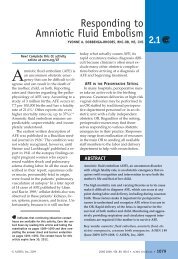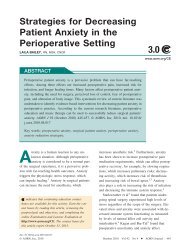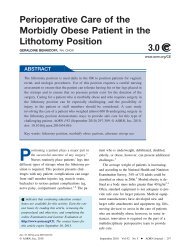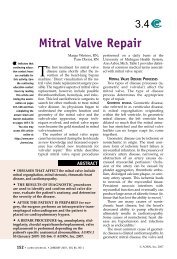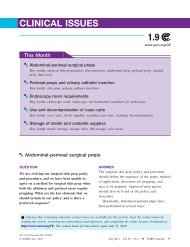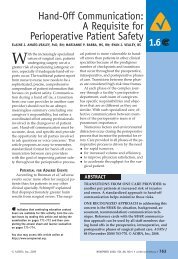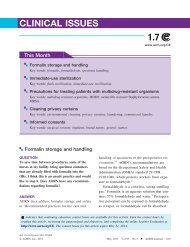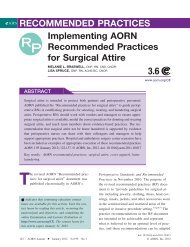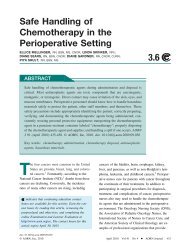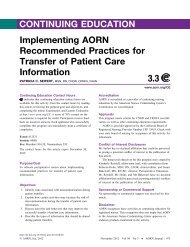Implementing AORN Recommended Practices for Hand Hygiene
Implementing AORN Recommended Practices for Hand Hygiene
Implementing AORN Recommended Practices for Hand Hygiene
Create successful ePaper yourself
Turn your PDF publications into a flip-book with our unique Google optimized e-Paper software.
RECOMMENDED PRACTICES<strong>Implementing</strong> <strong>AORN</strong><strong>Recommended</strong> <strong>Practices</strong><strong>for</strong> <strong>Hand</strong> <strong>Hygiene</strong>MARCIA PATRICK, MSN, RN, CIC;SHARON A. VAN WICKLIN, MSN, RN, CNOR, CRNFA, CPSN, PLNC2.7ABSTRACTThis article focuses on implementing the revised <strong>AORN</strong> “<strong>Recommended</strong> practices<strong>for</strong> hand hygiene in the perioperative setting.” The content of the document has beenexpanded and reorganized from the previous iteration and now includes specificactivity statements about water temperature, water and soap dispensing controls, thetype of dispensers to use, paper towel dispenser requirements, placement of soap andrub dispensers, and regulatory requirements <strong>for</strong> products and recommendations <strong>for</strong>hand hygiene practices. A successful hand hygiene program allows end users to haveinput into the selection and evaluation of products and should include educatingpersonnel about proper hand hygiene, product composition and safety, and how andwhen to use specific products. Measures <strong>for</strong> competency evaluation and compliancemonitoring include observations, quizzes, skills labs, electronic monitoring systems,handheld device applications, and data collection <strong>for</strong>ms. <strong>AORN</strong> J 95 (April 2012)492-504. © <strong>AORN</strong>, Inc, 2012. doi: 10.1016/j.aorn.2012.01.019Key words: <strong>AORN</strong> recommended practices, hand hygiene, surgical hand antisepsis.www.aorn.org/CEThe revised <strong>AORN</strong> “<strong>Recommended</strong> practices<strong>for</strong> hand hygiene in the perioperativesetting” document was publishedonline in <strong>AORN</strong>’s Perioperative Standards andindicates that continuing education contacthours are available <strong>for</strong> this activity. Earn the contacthours by reading this article, reviewing thepurpose/goal and objectives, and completing theonline Examination and Learner Evaluation athttp://www.aorn.org/CE. The contact hours <strong>for</strong>this article expire April 30, 2015.<strong>Recommended</strong> <strong>Practices</strong> in July 2009 and subsequentlyin the 2010 print edition of the book.The purpose of the revised recommended practices(RP) document is to “provide guidance <strong>for</strong>hand hygiene <strong>for</strong> surgical and other invasiveprocedures.” 1(p73) The RP includes seven recommendationsthat will help perioperative RNs identifyspecific practices representing an optimal andachievable level of hand hygiene in the perioperativesetting. These recommendations can beadapted to various settings where surgical andother invasive procedures are per<strong>for</strong>med.doi: 10.1016/j.aorn.2012.01.019492 <strong>AORN</strong> Journal ● April 2012 Vol 95 No 4 © <strong>AORN</strong>, Inc, 2012
RP IMPLEMENTATION GUIDE: HAND HYGIENEwww.aornjournal.orgWHAT’S NEWThe 2009 “<strong>Recommended</strong> practices <strong>for</strong> hand hygienein the perioperative setting” 1 supersedes the2005 document, “<strong>Recommended</strong> practices <strong>for</strong> surgicalhand antisepsis/hand scrubs.” 2 The primarychanges do not relate as much to content revisionas they do to expansion and reorganizationof the content. Procedures <strong>for</strong> hand washinghave been separated from procedures <strong>for</strong> surgicalhand antisepsis, and each is now the topicof a distinct recommendation. Instructions <strong>for</strong>surgical hand antisepsis using an antimicrobialsurgical scrub agent and surgical hand antisepsisusing an alcohol-based antiseptic rub havebeen combined into a single recommendationrather than remaining two separate recommendationsas they were previously.Several new activity statements have beenadded to address various aspects of handhygiene, 1(p76) including the need <strong>for</strong> water temperature at the faucet to be maintainedbetween 105° F and 120° F (40.6° C to48.9° C), hands-free water and soap dispensing controlsin new or remodeled facilities, paper towel dispensers designed in a mannerthat prevents recontamination of the handswhen removing towels, and proper placement of alcohol-based hand antisepticproduct dispensers in areas wheresurgical and other invasive proceduresare per<strong>for</strong>med.<strong>Hand</strong> antiseptic product dispensers that containflammable antiseptics may be a fire hazard in areaswhere oxygen and ignition sources are present;there<strong>for</strong>e, an activity statement was added toaddress the importance of dispensers being installedin accordance with the National Fire ProtectionAssociation Life Safety Code as well asstate and local regulations.The previous RP document contained a singlerecommendation <strong>for</strong> developing policies and proceduresthat also discussed the need <strong>for</strong> educatingperioperative personnel regarding surgical handantisepsis. The current RP document includesthree separate recommendations related to educationand competency validation, policy and proceduredevelopment, and quality management programs.The current RP document also includes atable that compares the activity of hand hygieneagents and various considerations that should betaken into account when selecting them.RATIONALEMore than 150 years ago, Ignaz Semmelweis andOliver Wendell Holmes independently concludedthat the hands of health care providers couldtransmit infection to patients. They each demonstratedthat the use of an antiseptic substantiallyreduced the risk of infection, 3 but it took decades<strong>for</strong> hand hygiene to achieve widespread acceptanceas a valuable infection prevention tool.Infections acquired during treatment <strong>for</strong> medicalor surgical conditions are known as healthcare-associated infections (HAIs). 4 Health careassociatedinfections can occur in all patient caresettings and are associated with a variety ofcauses (eg, medical devices such as cathetersand ventilators, overuse of antibiotics, transmissionbetween patients and health care workers).4 Health care-associated infections mayarise from a wide variety of common and uncommonbacteria, viruses, and fungi. 3 As of2007, the greatest percentage of HAIs were urinarytract infections (34%), followed by surgicalsite infections (17%), bloodstream infections(14%), and pneumonia (13%). 5A significant cause of morbidity and mortality,HAIs have been estimated to account <strong>for</strong>approximately 1.7 million infections and 99,000deaths in the United States each year. 5 Hospitalstays <strong>for</strong> methicillin-resistant Staphylococcusaureus (MRSA) infections have increased almost10-fold since 1995 and have more thantripled since 2000. 6Prevention of HAIs must be a priority <strong>for</strong> allhealth care personnel, regardless of their work<strong>AORN</strong> Journal 493
April 2012 Vol 95 No 4 PATRICK—VAN WICKLINsetting. Lack of appropriate hand hygiene isconsidered to be the leading cause of HAIs andthe spread of multidrug-resistant organisms andassociated outbreaks, 3 yet it has been estimatedthat adherence to optimal hand hygiene practicesby health care providers is less than 50%. 7 Althoughthe definitive effect of improved hand hygieneon HAIs has not been identified, evidencesupports the theory that effective hand hygiene byhealth care providers can substantially reduceinfection rates. 3As a result of HAIs, it is estimated that annualhealth care costs in the United States are increasedby $28 billion to $33 billion. 8 The Centers <strong>for</strong>Medicare & Medicaid Services has implementedfinancial disincentives by refusing to reimbursehealth care organizations <strong>for</strong> costs associated with“hospital acquired infections.” 9 Public reporting ofinfections is now required in 31 states and the Districtof Columbia, one state has voluntary reporting,and five other states have a study law (ie, a lawfloated be<strong>for</strong>e the legislature without an intent topass it at that time or in that <strong>for</strong>m) in progress. 10DISCUSSIONEffective hand hygiene by health care personnelsupports the maxim of “first, do no harm.” <strong>Hand</strong>hygiene is currently considered to be the cornerstone<strong>for</strong> preventing the spread of pathogenicorganisms. To be effective, implementation ofadvances in practices and products requires a<strong>AORN</strong> Resources Confidence-Based Learning module: <strong>Hand</strong> <strong>Hygiene</strong> in thePerioperative Setting. http://www.aorn.org/Education/Curriculum/Confidence_Based_Learning/<strong>Hand</strong>_<strong>Hygiene</strong>_in_the_Perioperative_Setting_CBL.aspx. Periop 101: A Core Curriculum. http://www.aorn.org/Education/Curriculum/Periop101/Periop_101.aspx. <strong>AORN</strong> Clinical Answers: hand hygiene. http://www.aorn.org/Clinical_Practice/Clinical_Answers/Clinical_Answers.aspx.Web site access verified December 19, 2011.programmatic approach. This includes developingand implementing policies that govern the processesand products used, as well as monitoringcompliance with these policies. It is the responsibilityof the professional perioperative RN to ensuresafe, high-quality nursing care to patientsundergoing surgical and invasive procedures inall settings.Educating health care providers on hand care,hand antisepsis, and the purpose and proper useof products is critical <strong>for</strong> a facility’s hand hygieneprogram. Education begins with new employeeorientation. Orientation checklists are a good wayto keep track of new employee education—theseshould include the elements of proper hand hygieneas well as elements related to product safety(eg, flammability, chemicals, material safety datasheets). A solid orientation helps ensure thatnew perioperative employees have the requisiteknowledge and skills to properly per<strong>for</strong>m thetasks associated with their position and to helpprevent future problems. It is also important toprovide ongoing education to all perioperativeemployees as a reminder of existing policiesand as changes arise in products, equipment,processes, and procedures.Recommendation I“All health care personnel should follow establishedhand hygiene practices <strong>for</strong> maintaininghealthy skin and fingernailcondition and regarding thewearing of jewelry in theperioperative setting.” 1(p73)Perioperative personnel mustunderstand how to properlycare <strong>for</strong> their hands toprevent skin irritation and toprotect patients from pathogenicorganisms. Personnelwill likely not use productsthat give them rashes orcause other skin irritation.The use of alcohol-based494 <strong>AORN</strong> Journal
RP IMPLEMENTATION GUIDE: HAND HYGIENEwww.aornjournal.orghand rubs containing emollients may help to reduceskin damage, dryness, and irritation fromantiseptic preparations. 3 Irritated skin can becomerough and broken, allowing colonization withpathogenic organisms that can be transmitted topatients or the patient’s environment and also increasingthe potential <strong>for</strong> acquiring transmissibleinfections from the patient. 11 Following the manufacturer’sinstructions <strong>for</strong> hand hygiene productuse increases product effectiveness and helps tomaintain skin integrity.A good example is the need <strong>for</strong> wettinghands be<strong>for</strong>e applying soap when washing.Most hand soap manufacturers and the Centers<strong>for</strong> Disease Control and Prevention 3 recommendthis, but it is a skin-protective practicethat sometimes is ignored. Wetting the handsloosens transient soil and makes it easier to remove.Wetting the hands also helps disperse theproduct more evenly and aids in developing alather that may enhance skin penetration. Usingtoo much or too little of a product also can bea problem. Too much product can be difficultto rinse off, causing skin irritation. Using toolittle can result in inadequate cleansing or disinfectionof the skin. Water temperature shouldbe maintained between 105° F to 120° F becausea com<strong>for</strong>table temperature improves useracceptance and aids in preventing dermatitis. 12Thorough drying helps remove soil loosenedduring hand washing, andblotting rather than rubbingcan decrease skin irritation.Health care providersshould adhere to the followingpractices:6300, option 3.Keep fingernails short, notto exceed 1/4 inch. 13 Aneasy and effective way toensure that nails are theproper length is to holdthe hand vertically andlook at the palmar side;nails should not extend beyond the tip of thefinger (Figure 1). Do not wear artificial nails, including resinbonding, extensions, tips, gels, acrylic overlays,resin wraps, or acrylic nails. 14 Maintain nail polish. Nail polish is acceptable aslong as it is not chipped, cracked, or crazed. 15,16 Do not wear jewelry on the hands or wrists.<strong>Hand</strong> and wrist jewelry traps bacteria. 3,13,15,17 Use hand lotion that is compatible with bothgloves and antiseptic hand hygiene products.3,18,19 As with other hand hygiene products,lotions should be evaluated and approvedby an interdisciplinary group with the authorityto evaluate and select hand lotions. Exclude health care providers from the perioperativeenvironment if they pose a threat topatient safety (eg, health care providers whohave cuts, abrasions, weeping dermatitis, orfresh tattoos on exposed skin should notprovide direct patient care until the skinis healed).To effectively implement this recommendation,perioperative personnel will need to be educatedabout appropriate practices and products. Educationshould cover product composition, how toproperly use products, and the specific functionand application of each product in use at the facility.For example, alcohol-based foam is not asurgical scrub and should not be used <strong>for</strong> thisResources <strong>for</strong> Implementation <strong>AORN</strong> Nurse Consult Line. (800) 755-2676 or (303) 755- OR Nurse Link. http://www.aorn.org/ORNurseLink. Perioperative Job Descriptions and Competency EvaluationTools [CD-ROM]. http://www.aorn.org/Books_and_Publications/<strong>AORN</strong>_Publications/Perioperative_Job_Descriptions_and_Competency_Evaluations_Tools.aspx.Web site access verified December 19, 2011.<strong>AORN</strong> Journal 495
April 2012 Vol 95 No 4 PATRICK—VAN WICKLINFigure 1. Nails should not extend beyond the tips of the fingers.purpose. If a facility’s policy states to use products“per manufacturer’s instructions,” the mostcurrent instructions must be available and teammembers should be educated on the contents ofthe instructions and where to find them. Using apersonal calendar that indicates when hand hygieneeducational activities and monitoring shouldoccur can be very useful <strong>for</strong> perioperative RNsoverseeing hand hygiene compliance in thefacility.Education should be tailored to the specificpersonnel. For example, individuals who functionin the role of scrub person will require additionaleducation and competency validation in surgicalhand antisepsis. Education should be provided oninitial hire and at least annually afterwards, aswell as any time products or procedures change.Recommendation II“A standardized procedure <strong>for</strong> hand washingshould be followed.” 1(p75) A proper hand washincludes using the correct product and correctamount of product; applying it <strong>for</strong> the requiredamount of time; and covering all hand, wrist, andfinger surfaces.A perioperative health care provider must washhis or her hands when coming on and leavingduty, be<strong>for</strong>e and after each contact with a patientor the patient’s environment, on donning or removinggloves, be<strong>for</strong>e and after eating or usingthe restroom, any time there is a possibility thatthere has been contact with blood or other potentiallyinfectious materials or surfaces, and whenhands are visibly soiled. 3,20Wearing gloves does not replace the need <strong>for</strong>hand hygiene. 21 When gloves are removed, handsmust be washed or an alcohol-based hand rubused. 22,23 Washing hands with soap and water <strong>for</strong> atleast 15 seconds has been shown to be effective inremoving pathogenic organisms. 3,20 The Centers <strong>for</strong>Disease Control and Prevention recommends the useof an alcohol-based hand rub instead of soap andwater when hands are not visibly soiled. 3To per<strong>for</strong>m the proper procedure <strong>for</strong> handwashing, 3 health care providers should take thefollowing steps:496 <strong>AORN</strong> Journal
RP IMPLEMENTATION GUIDE: HAND HYGIENEwww.aornjournal.orgFigure 2. Application of alcohol-based hand rub. Remove hand and wrist jewelry. Use warm water to wet hands. Apply soap per the manufacturer’s recommendations. Scrub all skin surfaces, including wrists, backsof hands, fingertips, inner webs, and palms <strong>for</strong>at least 15 seconds. Rinse thoroughly to remove all of the soap. Dry with nonabrasive, absorbent, disposablepaper towels. Use paper towels to turn off the faucets and toopen the door, if necessary, to prevent recontaminationof hands.<strong>Hand</strong> washing stations should be convenientlylocated throughout the facility and according tolocal and state building codes. 12 The Guidelines<strong>for</strong> Design and Construction of Health Care Facilities,2010 24 is an excellent resource <strong>for</strong> sinkplacement requirements.Cartridge-type soap dispensers should beused because refillable soap containers can becomecontaminated and spread pathogens to theusers’ hands. 25 Paper towel holders should allowthe user to pull down a single towel withouttouching the dispenser. Towels should bedispensed from the bottom of the dispenser.In-counter containers that dispense from the topare not acceptable because they become contaminatedeasily. 26 Use of paper towels that arestacked on top of the dispenser or on a countershould be discouraged <strong>for</strong> the same reason.If hands are not visibly soiled, an alcoholbasedhand rub may be used 3 by dispensing themanufacturer-recommended amount of productand briskly rubbing all skin surfaces until theproduct is dry (Figure 2). Considerations <strong>for</strong> usingalcohol-based hand rub dispensers includethe following: An alcohol-based hand rub must contain atleast 60% alcohol <strong>for</strong> use in a health care setting.Currently, there are no alcohol-free productsthat meet the criteria <strong>for</strong> health care use. 3 The 2004 National Fire Protection AssociationLife Safety Code requires alcohol-based handrub dispensers be placed at least 4 feet apart;hold no more than 1.2 L in rooms, corridors,and areas open to corridors; and not be placedwithin 6 inches of an electrical outlet orswitch. 20,27 State or local regulations may bemore stringent. Alcohol-based hand rub containers should bedisposable and never refilled from another<strong>AORN</strong> Journal 497
April 2012 Vol 95 No 4 PATRICK—VAN WICKLINcontainer. 28 Some facilities have placedalcohol-based hand rub containers immediatelyoutside each OR and require team membersto “gel/foam in, gel/foam out.” Frequent andconsistent use is particularly important relativeto multidrug-resistant organisms that personnelmay or may not be aware of in an individualpatient. Dispenser locations that are convenientand easily spotted are likely to increasecompliance. 3 Other areas in which to placealcohol-based hand rub dispensers to encouragehand hygiene include the control desk, thenursing station, anesthesia carts, and lounge orbreak rooms. New construction and remodeled facilitiesshould include hands-free faucets, soap dispensers,and alcohol-based hand rub dispensersbecause these reduce the risk of crosscontamination.It is important to have teammember input on placement of sinks, soap,alcohol-based hand rub and towel dispensers,or any other critical element related to handhygiene in any OR renovation or constructionproject.As patient advocates with a responsibility toensure safe patient care, perioperative RNs musttake an active role in following, modeling, andpromoting best practices <strong>for</strong> hand hygiene. In somuch as it is possible, perioperative RNs shouldactively monitor that hand hygiene polices andprocedures are being followed by colleagues andteam members. Additionally, perioperative RNsshould support and participate in the health careorganization’s educational activities and work toensure that engineering controls (eg, hand washingstations) are provided and that hand hygieneis easy and convenient throughout the facility.Competency and compliance process measureevaluations <strong>for</strong> the hand hygiene program can beaccomplished through observation of per<strong>for</strong>manceand verbal quizzing of perioperative personnel onelements of the program—are they familiar withthe products, indications, contraindications, andproper use and the special precautions <strong>for</strong> alcoholbasedproducts to reduce the risk of fire? Canthey locate the manufacturers’ written instructionsand recommendations <strong>for</strong> use of the products andthe material safety data sheets? Observations areanother excellent tool <strong>for</strong> measuring compliancewith hand hygiene. One can observe an individual’sper<strong>for</strong>mance from beginning to end <strong>for</strong> a singleprocedure, checking that all the elements inthe competency evaluation tool are being per<strong>for</strong>medcorrectly or by observing hand hygiene ofall personnel at the start of the day. Another optionis to implement skills labs, during whicheach employee is required to go through a stationand correctly per<strong>for</strong>m a skill or task. This providesan opportunity to work one-on-one withanyone who is having a problem. There are alsoelectronic monitors available that sense when thehealth care provider is approaching the patientand whether the health care provider activateseither the soap or alcohol-based hand rub dispenser.Other monitoring systems read badges atsinks and record the amount of time spent; videomonitoring can also be used to ascertain compliance.These electronic systems provide compliancereports by individual, unit, and facility, butthey are expensive to acquire and use. 29-33Recommendation IIIA surgical hand scrub should be per<strong>for</strong>medby health care providers be<strong>for</strong>e donning sterilegloves <strong>for</strong> surgical or other invasive procedures.Use of either an antimicrobial surgicalscrub agent intended <strong>for</strong> surgical handantisepsis or an alcohol-based antiseptic surgicalhand rub with documented persistentand cumulative activity that has met USFood and Drug Administration (FDA) regulatoryrequirements <strong>for</strong> surgical hand antisepsisis acceptable. 1(p77)All products used as surgical hand scrubs must beFDA approved <strong>for</strong> this purpose. 34 Surgical handantisepsis will only be successful if all skin surfacesare exposed to the mechanical cleaning and498 <strong>AORN</strong> Journal
RP IMPLEMENTATION GUIDE: HAND HYGIENEwww.aornjournal.orgchemical antisepsis process. A fast-drying alcoholand chlorhexidine product that has persistence andresidual effect is preferred. 3When using an alcohol-based surgical handantiseptic, perioperative health care providersshould complete the following steps 3 : Remove rings, watches, bracelets, and otherhand jewelry. Don a surgical mask—surgical masks shouldbe worn by all personnel at the scrub sinkduring hand scrub activity. Prewash hands and <strong>for</strong>earms if they are visiblysoiled. Clean under fingernails with a disposable nailpick under running water (Figure 3). Rinse hands and <strong>for</strong>earms under runningwater. Dry hands and <strong>for</strong>earms thoroughly with disposablepaper towels. Dispense the manufacturer-recommendedamount of surgical antisepsis product andapply it to hands and <strong>for</strong>earms according tothe manufacturer’s recommendations. Repeat application as directed. Rub thoroughly until completely dry. For surgical or invasive procedures, don asterile surgical gown and sterile gloves in theOR or procedure room.When using a traditional scrub-with-water product<strong>for</strong> surgical hand antisepsis, perioperativehealth care providers should complete the followingsteps 15 : Remove rings, watches, bracelets, and otherhand jewelry. Don a surgical mask—surgical masks shouldbe worn by all personnel at the scrub sinkduring hand scrub activity. Prewash hands and <strong>for</strong>earms with soap andwater if they are visibly soiled. Clean under fingernails with a nail pick underrunning water. Rinse hands and <strong>for</strong>earms under runningwater. Dispense the approved antimicrobial scrubproduct per the manufacturer’s writteninstructions. Apply to wet <strong>for</strong>earms and hands using a soft,nonabrasive sponge. 13,35 Keeping hands elevated, methodically scruball skin surfaces with a sponge <strong>for</strong> threeFigure 3. Cleaning the areas under fingernails during surgical hand scrub.<strong>AORN</strong> Journal 499
April 2012 Vol 95 No 4 PATRICK—VAN WICKLINto five minutes, per the manufacturer’sinstructions. For water conservation, turn off the faucetwhen it is not in use, if possible. Avoid splashing surgical attire. Discard sponges in an appropriate container. Keeping hands elevated, rinse hands and <strong>for</strong>earmsfrom fingertips to elbows under runningwater (Figure 4). In the OR, dry thoroughly with a sterile surgicaltowel be<strong>for</strong>e donning sterile gown andgloves.One strategy <strong>for</strong> improving hand hygienecompliance in health care facilities is routineobservation and feedback. It is often valuableto have different team members be responsible<strong>for</strong> monitoring hand hygiene complianceat various times. Assigned team membersshould be provided with instructions as to thespecific activities to observe and how to recordobservations. There are software applicationsthat can be tailored to a specific unit and resultsentered into a handheld device. 36 Additionally,sample compliance data collection<strong>for</strong>ms are available in the Institute <strong>for</strong> HealthcareImprovement hand hygiene tool kit. 37Recommendation IVSurgical hand hygiene products should be selectedfollowing an analysis of product effectiveness,application requirements, and user acceptance.” 1(p78)Perioperative RNs can participate in the collaborativeevaluation process as members of the multidisciplinaryinfection prevention and control committeeand as individual end users. To maximize productacceptance, end users of surgical hand hygieneproducts should have input into the selection andevaluation regarding the feel, fragrance, and skintolerance of such products. Products that are notwell accepted by end users can be a deterrent tofrequent hand hygiene. 20 Written evaluation criteriashould include, but not be limited to, the following:Figure 4. Rinsing from fingertips to elbows during surgical hand scrub.500 <strong>AORN</strong> Journal
RP IMPLEMENTATION GUIDE: HAND HYGIENEwww.aornjournal.org safety, purpose and use, ease of use, skin com<strong>for</strong>t and reaction, fragrance, consistency, color, compatibility with other products, patient and health care provider outcomes, efficacy, regulatory control (eg, fire standards, FDAapproval), and cost.Cost is listed last because product selectionshould not be made on the basis of cost alone.It is unlikely that a single product will work<strong>for</strong> everyone. There will always be a small numberof health care providers who will be sensitiveto any given product, so often multiple productsare needed to serve all health care providers.This can frustrate purchasing personnel who tryto standardize and reduce the number of likeproducts; however, it is better to have severalacceptable products and reduce skin irritationissues than a single product that does not work<strong>for</strong> everyone. A material safety data sheet mustbe on file and readily available <strong>for</strong> each productused in the facility, including sample products.Facility policies and procedures shouldclearly delineate hand hygiene products (eg,soaps, antiseptics, lotions) that are to be used inthe facility. Policies and procedures also shouldinclude written criteria <strong>for</strong> evaluation and selectionof hand hygiene products and identify thedesignated approving body and those individuals,including end users, to be involved in theevaluation process.The Final ThreeIn the “<strong>Recommended</strong> practices <strong>for</strong> hand hygienein the perioperative setting,” 1 the final three recommendationsdiscuss education/competency,policies and procedures, and quality assurance/per<strong>for</strong>mance improvement. These topics are integralto the implementation of <strong>AORN</strong> practice recommendations.Personnel should receive initialand ongoing education and competency validationas applicable to their roles. <strong>Implementing</strong> newand updated recommended practices af<strong>for</strong>ds anexcellent opportunity to create or update competencymaterials and validation tools. <strong>AORN</strong>’sperioperative competencies team has developedthe <strong>AORN</strong> Perioperative Job Descriptions andCompetency Evaluation Tools 38 to assist perioperativepersonnel in developing competency evaluationtools and position descriptions.Policies and procedures should be developed,reviewed periodically, revised as necessary, andreadily available in the practice setting. New orupdated recommended practices may present anopportunity <strong>for</strong> collaborative ef<strong>for</strong>ts with nursesand personnel from other departments in the facilityto develop organization-wide policies and proceduresthat support the recommended practices.The <strong>AORN</strong> Policy and Procedure Templates, 2ndedition, 39 provides a collection of 15 sample policiesand customizable templates based on <strong>AORN</strong>’sPerioperative Standards and <strong>Recommended</strong> <strong>Practices</strong>.Regular quality improvement projects are necessaryto improve patient safety and to ensure safe,quality care. For details on the final three practicerecommendations that are specific to the RP documentdiscussed in this article, please refer to the fulltext of the RP document.AMBULATORY PATIENT SCENARIONurse S works in the postanesthesia care unit atan orthopedic surgical facility. After helpingNurse T per<strong>for</strong>m a dressing change on Mr P, whounderwent a knee arthroscopy, Nurse S seesNurse T enter a cubicle and begin caring <strong>for</strong>another postoperative patient without washing hishands. What actions should Nurse S take?Nurse S must recognize that by failing to per<strong>for</strong>mproper hand hygiene, Nurse T is puttinghimself, his patients, and other facility personnelat risk <strong>for</strong> infection. The appropriate action <strong>for</strong>Nurse S would be to respectfully remind Nurse T<strong>AORN</strong> Journal 501
April 2012 Vol 95 No 4 PATRICK—VAN WICKLINabout the need to per<strong>for</strong>m proper hand hygienebe<strong>for</strong>e and after every patient contact. Nurse Scould refer to the facility policy and procedureand emphasize the importance of proper handhygiene by all members of the health care teamin preventing HAIs and reducing the potential<strong>for</strong> acquiring transmissible infections. Nurse Salso may want to report her concerns to hernurse manager.HOSPITAL PATIENT SCENARIONurse R is employed as a perioperative RN in thevascular surgery department at a community hospital.He has been assigned to circulate <strong>for</strong> a laparoscopiccholecystectomy with a new scrub person.As the scrub person begins to scrub herhands at the sink, Nurse R notices that the scrubperson appears to have a moderate case of weepingdermatitis on her right wrist. When questionedabout this, the scrub person states that shewas embarrassed and afraid to mention her condition<strong>for</strong> fear of losing her job. She further statesthat the procedure is minimally invasive and shedoes not think it really matters because the affectedskin will be covered with her sterile gownand two pair of gloves. What actions shouldNurse R take?Nurse R should understand that health carepersonnel with breaks in skin integrity may be atrisk <strong>for</strong> acquiring or transmitting infections. NurseR should express his concern to the scrub personthat she is putting herself at risk by not allowingthe affected area to heal. He should take action toensure that she does not scrub in on the procedureand immediately report his concerns to his nursemanager. The scrub person should not be allowedto have patient contact until the condition ishealed and she has been cleared by an infectionpreventionist, employee health or occupationalhealth nurse, or other health care professionalwith specialized knowledge in making a determinationregarding the safety of the employee returningto work in the perioperative setting.CONCLUSIONA comprehensive hand hygiene program canimprove team member compliance with handhygiene measures and help to ensure patientsafety. Products <strong>for</strong> hand hygiene that are acceptable<strong>for</strong> users, hand washing stations andalcohol-based hand rub dispensers located instrategic areas, and clear expectations and en<strong>for</strong>cedpolicies <strong>for</strong> perioperative personnel setthe stage <strong>for</strong> uni<strong>for</strong>m compliance.A critical element in an effective hand hygieneprogram is the need <strong>for</strong> financial resourcesto accomplish the program goals. Fundingto accomplish the goals of the hand hygieneprogram is essential <strong>for</strong> the program to succeed.The organization’s financial plan or budgetshould include funding <strong>for</strong> acceptable handhygiene products, systems <strong>for</strong> per<strong>for</strong>mancemonitoring, and education on hand hygiene.Reducing infections will save money over timeand will lead to improved patient outcomes andhealth care provider satisfaction.References1. <strong>Recommended</strong> practices <strong>for</strong> hand hygiene in theperioperative setting. In: Perioperative Standardsand <strong>Recommended</strong> <strong>Practices</strong>. Denver, CO: <strong>AORN</strong>,Inc; 2012:73-86.2. <strong>Recommended</strong> practices <strong>for</strong> surgical hand antisepsis/hand scrubs. In: Standards, <strong>Recommended</strong> <strong>Practices</strong>,and Guidelines. Denver, CO: <strong>AORN</strong>, Inc; 2005:377-385.3. Guideline <strong>for</strong> hand hygiene in health-care settings. Recommendationsof the Healthcare Infection Control <strong>Practices</strong>Advisory Committee and the HICPAC/SHEA/APIC/IDSA <strong>Hand</strong> <strong>Hygiene</strong> Task Force. MMWR. 2002;51(RR-16):1-2. http://www.cdc.gov/mmwr/PDF/rr/rr5116.pdf.Accessed December 16, 2011.4. HHS Action Plan to Prevent Healthcare-AssociatedInfections. June 2009. US Department of Health & HumanServices. http://www.hhs.gov/ash/initiatives/hai/infection.html. Accessed January 3, 2012.5. Klevens RM, Edwards JR, Richards CL Jr, et al. Estimatinghealth care-associated infections and deaths inUS hospitals, 2002. Public Health Rep. 2007;122(2):160-166.6. Elixhauser A, Steiner C. Infections with methicillinresistantStaphylococcus aureus (MRSA) in US hospitals,1993-2005. Healthcare Cost and Utilization ProjectStatistical Brief. July 2007. http://www.hcup-us.ahrq.gov/reports/statbriefs/sb35.pdf. Accessed January 3,2012.502 <strong>AORN</strong> Journal
RP IMPLEMENTATION GUIDE: HAND HYGIENEwww.aornjournal.org7. Suresh G, Cahill J. How “user friendly” is the hospital<strong>for</strong> practicing hand hygiene? An ergonomic evaluation.Jt Comm J Qual Patient Saf. 2007;33(3):171-179.8. Scott RD II. The Direct Medical Costs of Healthcare-Associated Infections in US Hospitals and the Benefitsof Prevention. Atlanta, GA: Centers <strong>for</strong> Disease Controland Prevention; 2009. http://www.cdc.gov/HAI/pdfs/hai/Scott_CostPaper.pdf. Accessed January 3, 2012.9. Overview. Conditions <strong>for</strong> coverage (CfCs) & conditionsof participations (CoPs). Centers <strong>for</strong> Medicare & MedicaidServices. https://www.cms.gov/CFCsAndCoPs/.Accessed December 19, 2011.10. HAI reporting laws and regulations: states that haveenacted laws relating to reporting of healthcareassociatedinfections. Association <strong>for</strong> Professionals inInfection Control and Epidemiology, Inc. http://www.apic.org/downloads/legislation/HAI_map.gif. UpdatedJuly 6, 2011. Accessed December 19, 2011.11. Dental services. In: Molinari JA, Harte JA, eds. APICText of Infection Control and Epidemiology. Washington,DC: Association <strong>for</strong> Professionals in InfectionControl and Epidemiology; 2005: 51-1–51-22.12. AIA Academy of Architecture <strong>for</strong> Health, FacilitiesGuidelines Institute. Guidelines <strong>for</strong> Design and Constructionof Health Care Facilities. Washington, DC:American Institute of Architects; 2006.13. Graves PB, Twomey CL. Surgical hand antisepsis: anevidence-based review. Perioper Nurs Clin. 2006;1(3):235-246.14. McNeil SA, Foster CL, Hedderwick SA, Kauffman CA.Effect of hand cleansing with antimicrobial soap oralcohol-based gel on microbial colonization of artificialfingernails worn by health care workers. Clin InfectDis. 2001;32(3):367-372.15. WHO Guidelines on <strong>Hand</strong> <strong>Hygiene</strong> in Health Care(Advanced Draft). Geneva, Switzerland: World HealthOrganization; 2006. http://www.who.int/patientsafety/in<strong>for</strong>mation_centre/ghhad_download_link/en/. AccessedJanuary 3, 2012.16. Wynd CA, Samstag DE, Lapp AM. Bacterial carriageon the fingernails of OR nurses. <strong>AORN</strong> J. 1994;60(5):799-805.17. Salisbury DM, Hutfilz P, Treen LM, Bollin GE,Gautam S. The effect of rings on microbial load ofhealth care workers’ hands. Am J Infect Control. 1997;25(1):24-27.18. CPL 02-02-069–CPL 2-2.69: En<strong>for</strong>cement procedures<strong>for</strong> the occupational exposure to bloodborne pathogens.Occupational Safety & Health Administration. http://www.osha.gov/pls/oshaweb/owadisp.show_document?p_tableDIRECTIVES&p_id2570. Accessed January 3,2012.19. Marino C, Cohen M. Washington State hospital survey2000: gloves, handwashing agents, and moisturizers.Am J Infect Control. 2001;29(6):422-424.20. <strong>Hand</strong> hygiene. In: Underwood MA, ed. APIC Text ofInfection Control and Epidemiology. Washington, DC:Association <strong>for</strong> Professionals in Infection Control andEpidemiology; 2005:19-1–19-7.21. Kim PW, Roghmann MC, Perencevich EN, Harris AD.Rates of hand disinfection associated with glove use,patient isolation, and changes between exposure tovarious body sites. Am J Infect Control. 2003;31(2):97-103.22. Hubner NO, Kampf G, Kamp P, Kohlmann T,Kramer A. Does a preceding hand wash and dryingtime after surgical hand disinfection influence theefficacy of a propanol-based hand rub? BMC Microbiol.2006;6:57.23. Hubner NO, Kampf G, Loffler H, Kramer A. Effect ofa 1 min hand wash on the bactericidal efficacy of consecutivesurgical hand disinfection with standard alcoholsand on skin hydration. Int J Hyg Environ Health.2006;209(3):285-291.24. Guidelines <strong>for</strong> Design and Construction of Health CareFacilities, 2010. Dallas, TX: Facilities Guideline Institute;2010. http://www.fgiguidelines.org/2010guidelines.html. Accessed January 3, 2012.25. Griffith CJ, Malik R, Cooper RA, Looker N, MichaelsB. Environmental surface cleanliness and the potential<strong>for</strong> contamination during handwashing. Am J InfectControl. 2003;31(2):93-96.26. Harrison WA, Griffith CJ, Ayers T, Michaels B. Bacterialtransfer and cross-contamination potential associatedwith paper-towel dispensing. Am J Infect Control.2003;31(7):387-391.27. NFPA 99 Standard <strong>for</strong> Health Care Facilities. Quincy,MA: National Fire Protection Association; 2005.28. <strong>Recommended</strong> practices <strong>for</strong> environmental cleaning inthe perioperative setting. In: Perioperative Standardsand <strong>Recommended</strong> <strong>Practices</strong>. Denver, CO: <strong>AORN</strong>, Inc;2012:237-250.29. Biovigil. http://www.biovigilsystems.com/products/.Accessed January 16, 2012.30. Ekahau infection control solution. ekahau. http://www.ekahau.com/solutions/healthcare/infection-control.html?gclidCL3Kqezd060CFQyb7QodbCTlmA. AccessedJanuary 16, 2012.31. UltraClenz ProGiene. http://www.ultraclenz.com/progiene.html. Accessed January 16, 2012.32. <strong>Hand</strong> hygiene monitoring system. equipmed. http://www.equipmed.com/infection-control/brands/higeia/hand-hygiene-monitoring-system. Accessed January 16,2012.33. Duke hand hygiene monitoring handwashing complianceboost. http://ondemand.duke.edu/video/21461/duke-hand-hygiene-monitoring-h. Accessed January 16,2012.34. Tentative final monograph <strong>for</strong> health-care antisepticdrug products. Fed Regist. 1994;59:31441-31452 (codifiedat 21 CFR §333, 369).35. Gupta C, Czubatyj AM, Briski LE, Malani AK. Comparisonof two alcohol-based surgical scrub solutionswith an iodine-based scrub brush <strong>for</strong> presurgical antisepticeffectiveness in a community hospital. J HospInfect. 2007;65(1):65-71.36. iScrub Lite [software application]. iTunes Preview.http://itunes.apple.com/us/app/iscrub-lite/id329764570?mt8. Accessed January 3, 2012.37. How-to Guide: Improving <strong>Hand</strong> <strong>Hygiene</strong>. A Guide <strong>for</strong>Improving <strong>Practices</strong> Among Health Care Workers.Cambridge, MA: Institute <strong>for</strong> Healthcare Improvement;<strong>AORN</strong> Journal 503
April 2012 Vol 95 No 4 PATRICK—VAN WICKLIN2011. Last modified July 8, 2011. http://www.sheaonline.org/Assets/files/IHI_<strong>Hand</strong>_<strong>Hygiene</strong>.pdf.Accessed January 3, 2012.38. Perioperative Job Descriptions and Competency EvaluationTools [CD-ROM]. Denver, CO: <strong>AORN</strong>, Inc;2012.39. Policy & Procedure Templates, 2nd ed [CD-ROM].Denver, CO: <strong>AORN</strong>, Inc; 2010.Resources1. Guideline <strong>for</strong> Prevention of Surgical Site Infection, 1999.Atlanta, GA: Centers <strong>for</strong> Disease Control and Prevention;1999. http://www.cdc.gov/hicpac/SSI/001_SSI.html.Accessed December 19, 2011.2. Health Solutions Lab: University of Pennsylvania Schoolof Medicine—Partners in Your Care. Center <strong>for</strong> HealthTrans<strong>for</strong>mation. http://www.healthtrans<strong>for</strong>mation.net/cs/university_of_pennsylvania_school_of_medicine_partners_in_your_care. Accessed December 19, 2011.3. Surgical site infection (SSI) event. August 2011. Centers<strong>for</strong> Disease Control and Prevention. http://www.cdc.gov/nhsn/PDFs/pscManual/9pscSSIcurrent.pdf. Accessed December19, 2011.4. WHO Guidelines on <strong>Hand</strong> <strong>Hygiene</strong> in Health Care. FirstGlobal Patient Safety Challenge Clean Care is SaferCare. Geneva, Switzerland: World Health Organization;2009. http://whqlibdoc.who.int/publications/2009/9789241597906_eng.pdf. Accessed December 19, 2011.Marcia Patrick, MSN, RN, CIC, is the Association<strong>for</strong> Professionals in Infection Controland Epidemiology liaison to the <strong>AORN</strong> <strong>Recommended</strong><strong>Practices</strong> Advisory Board and anindependent consultant, Tacoma, WA. MsPatrick has no declared affiliation that couldbe perceived as posing a potential conflict ofinterest in the publication of this article.Sharon A. Van Wicklin, MSN, RN, CNOR,CRNFA, CPSN, PLNC, is a perioperative nursingspecialist at <strong>AORN</strong>, Inc, Denver, CO. MsVan Wicklin has no declared affiliation thatcould be perceived as posing a potential conflictof interest in the publication of this article.This RP Implementation Guide is intended to be an adjunct to the complete recommended practicesdocument upon which it is based and is not intended to be a replacement <strong>for</strong> that document. Individualswho are developing and updating organizational policies and procedures should review and referencethe full recommended practices document.504 <strong>AORN</strong> Journal
EXAMINATIONCONTINUING EDUCATION PROGRAM<strong>Implementing</strong> <strong>AORN</strong> <strong>Recommended</strong><strong>Practices</strong> <strong>for</strong> <strong>Hand</strong> <strong>Hygiene</strong>2.7www.aorn.org/CEPURPOSE/GOALTo educate perioperative nurses about how to implement the <strong>AORN</strong> “<strong>Recommended</strong>practices <strong>for</strong> hand hygiene in the perioperative setting” in inpatient andambulatory settings.OBJECTIVES1. Describe new activity statements that have been included in the updated recommendedpractices document.2. Identify potential risks involved with insufficient hand hygiene practices.3. Discuss <strong>AORN</strong>’s practice recommendations <strong>for</strong> hand hygiene in the perioperativesetting.4. Discuss methods <strong>for</strong> implementing <strong>AORN</strong>’s practice recommendations <strong>for</strong> handhygiene.The Examination and Learner Evaluation are printed here <strong>for</strong> your convenience.To receive continuing education credit, you must complete the Examinationand Learner Evaluation online at http://www.aorn.org/CE.QUESTIONS1. For hand washing, water temperature at the faucetshould be maintained betweena. 75° F and 90° F (23.9° C and 32.2° C).b. 90° F and 105° F (32.2° C and 40.6° C).c. 105° F and 120° F (40.6° C and 48.9° C).d. 120° F and 135° F (48.9° C and 57.2° C).2. Lack of appropriate hand hygiene is consideredto be the second leading cause of health careassociatedinfections and the spread of multidrugresistantorganisms and associated outbreaks.a. trueb. false3. Critical elements of a facility’s hand hygiene programinclude educating health care providers on1. elements related to product safety.2. hand care.3. hand antisepsis.4. the purpose and proper use of products.a. 1 and 3 b. 2 and 4c. 2, 3, and 4 d. 1, 2, 3, and 44. Examples of proper use of hand hygiene productsin the perioperative setting include1. wetting the hands be<strong>for</strong>e applying soap.2. using more product than is recommended bythe manufacturer to ensure thorough cleansing.© <strong>AORN</strong>, Inc, 2012 April 2012 Vol 95 No 4 ● <strong>AORN</strong> Journal 505
April 2012 Vol 95 No 4 CE EXAMINATION3. partially drying hands with paper towels andallowing them to air dry completely.4. blotting rather than rubbing to dry.a. 1 and 4 b. 2 and 3c. 1, 3, and 4 d. 1, 2, 3, and 45. In the perioperative setting, health carepractitioners1. should keep fingernails shorter than 1/4 inch.2. may wear artificial nails but not extensionsor tips.3. may wear nail polish, as long as it is notchipped, cracked, or crazed.4. should use hand lotion that is compatible withgloves and antiseptic hand hygiene products.a. 1 and 4 b. 2 and 3c. 1, 3, and 4 d. 1, 2, 3, and 46. To implement the recommendation <strong>for</strong> followingestablished hand hygiene practices <strong>for</strong>maintaining healthy skin and fingernail condition,a facility’s education program1. should cover product composition and how toproperly use products.2. may include the use of personal calendars thatindicate when educational activities and monitoringshould occur.3. should be the same <strong>for</strong> personnel in all roles.4. should be provided on initial hire and at leastannually afterwards.a. 1 and 4 b. 2 and 3c. 1, 2, and 4 d. 1, 2, 3, and 47. Perioperative health care providers must washtheir hands1. any time there has been contact with potentiallyinfectious materials.2. be<strong>for</strong>e eating.3. be<strong>for</strong>e and after each contact with a patient orthe patient’s environment.4. after using the restroom.5. when coming on and leaving duty.6. on removing gloves.a. 1, 3, and 5 b. 2, 4, and 6c. 1, 2, 4, and 5 d. 1, 2, 3, 4, 5, and 68. Strategies that might help promote competencyand compliance with a facility’s hand hygieneprogram may include1. asking personnel to locate the manufacturer’sinstructions <strong>for</strong> use of a product.2. implementing skills labs during which eachemployee is required to correctly per<strong>for</strong>m askill or task.3. observing an individual’s per<strong>for</strong>mance frombeginning to end <strong>for</strong> a single procedure.4. using electronic monitors to track whetherhealth care providers activate soap or alcoholbasedhand rub dispensers.5. verbal quizzing of perioperative personnel onelements of the program.a. 3 and 5 b. 1, 2, and 4c. 1, 2, 3, and 4 d. 1, 2, 3, 4, and 59. When using an alcohol-based surgical hand antiseptic,the first step a perioperative health careprovider should complete is toa. don a surgical mask.b. prewash hands and <strong>for</strong>earms if they are visiblysoiled.c. remove rings, watches, bracelets, and otherhand jewelry.d. rinse hands and <strong>for</strong>earms under running water.10. To maximize acceptance of hand hygiene productsin the perioperative setting, written evaluationcriteria <strong>for</strong> hand hygiene products shouldinclude1. safety and efficacy.2. cost.3. ease of use.4. skin com<strong>for</strong>t and reaction.5. fragrance and color.6. compatibility with other products.a. 1, 3, and 5 b. 2, 4, and 6c. 1, 2, 3, and 6 d. 1, 2, 3, 4, 5, and 6The behavioral objectives and examination <strong>for</strong> this program were prepared by Kimberly Retzlaff, editor/team lead, with consultationfrom Rebecca Holm, MSN, RN, CNOR, clinical editor, and Susan Bakewell, MS, RN-BC, director, Perioperative Education.Ms Retzlaff, Ms Holm, and Ms Bakewell have no declared affiliations that could be perceived as posing potential conflicts of interestin the publication of this article.506 <strong>AORN</strong> Journal
LEARNER EVALUATIONCONTINUING EDUCATION PROGRAM<strong>Implementing</strong> <strong>AORN</strong> <strong>Recommended</strong><strong>Practices</strong> <strong>for</strong> <strong>Hand</strong> <strong>Hygiene</strong>2.7www.aorn.org/CEThis evaluation is used to determine the extentto which this continuing education programmet your learning needs. Rate the items asdescribed below.OBJECTIVESTo what extent were the following objectives of thiscontinuing education program achieved?1. Describe new activity statements that have beenincluded in the updated recommended practicesdocument. Low 1. 2. 3. 4. 5. High2. Identify potential risks involved with insufficienthand hygiene practices.Low 1. 2. 3. 4. 5. High3. Discuss <strong>AORN</strong>’s practice recommendations <strong>for</strong>hand hygiene in the perioperative setting.Low 1. 2. 3. 4. 5. High4. Discuss methods <strong>for</strong> implementing <strong>AORN</strong>’s practicerecommendations <strong>for</strong> hand hygiene.Low 1. 2. 3. 4. 5. HighCONTENT5. To what extent did this article increase yourknowledge of the subject matter?Low 1. 2. 3. 4. 5. High6. To what extent were your individual objectivesmet? Low 1. 2. 3. 4. 5. High7. Will you be able to use the in<strong>for</strong>mation from thisarticle in your work setting? 1. Yes 2. No8. Will you change your practice as a result ofreading this article? (If yes, answer question#8A. If no, answer question #8B.)8A. How will you change your practice? (Select allthat apply)1. I will provide education to my team regardingwhy change is needed.2. I will work with management to change/implement a policy and procedure.3. I will plan an in<strong>for</strong>mational meeting withphysicians to seek their input and acceptanceof the need <strong>for</strong> change.4. I will implement change and evaluate theeffect of the change at regular intervals untilthe change is incorporated as best practice.5. Other:8B. If you will not change your practice as a resultof reading this article, why? (Select all thatapply)1. The content of the article is not relevant tomy practice.2. I do not have enough time to teach othersabout the purpose of the needed change.3. I do not have management support to makea change.4. Other:9. Our accrediting body requires that we verify thetime you needed to complete the 2.7 continuingeducation contact hour (162-minute) program:This program meets criteria <strong>for</strong> CNOR and CRNFA recertification, as well as other continuing education requirements.<strong>AORN</strong> is accredited as a provider of continuing nursing education by the American Nurses Credentialing Center’s Commission on Accreditation.<strong>AORN</strong> recognizes these activities as continuing education <strong>for</strong> registered nurses. This recognition does not imply that <strong>AORN</strong> or the American Nurses Credentialing Centerapproves or endorses products mentioned in the activity.<strong>AORN</strong> is provider-approved by the Cali<strong>for</strong>nia Board of Registered Nursing, Provider Number CEP 13019. Check with your state board of nursing <strong>for</strong> acceptance of thisactivity <strong>for</strong> relicensure.Event: #12510; Session: #0001; Fee: Members $13.50, Nonmembers $27The deadline <strong>for</strong> this program is April 30, 2015.A score of 70% correct on the examination is required <strong>for</strong> credit. Participants receive feedback on incorrect answers. Eachapplicant who successfully completes this program can immediately print a certificate of completion.© <strong>AORN</strong>, Inc, 2012 April 2012 Vol 95 No 4 ● <strong>AORN</strong> Journal 507



